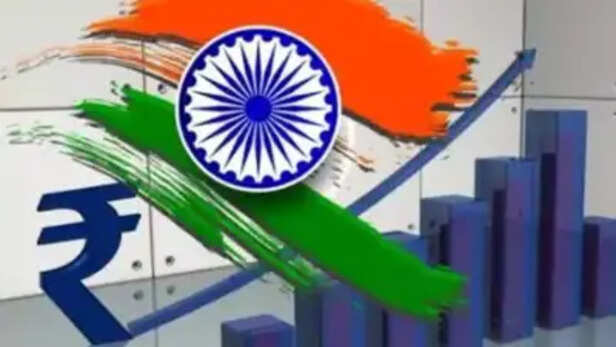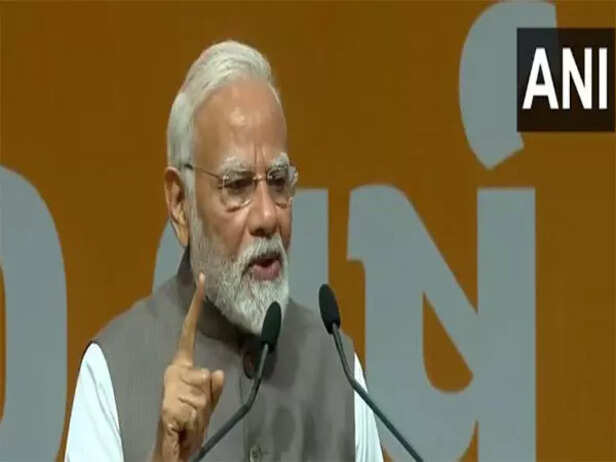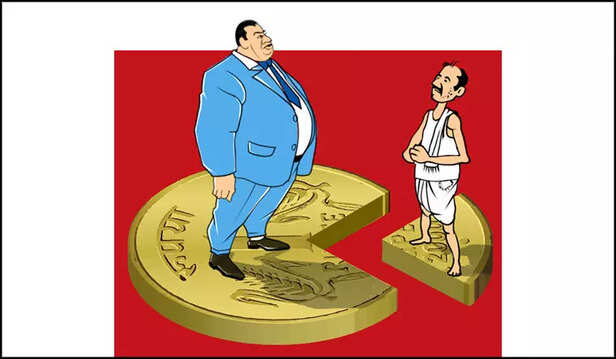Third Largest Economy? PM Modi Just Revealed What’s Coming for India!
Ankit Gupta | May 27, 2025, 20:51 IST
Prime Minister Narendra Modi has announced that India has ascended to become the world's fourth-largest economy, surpassing Japan, with a current GDP of approximately $4.18 trillion. This achievement marks a significant rise from its 11th position in 2014.
India has officially become the world’s fourth-largest economy, overtaking Japan, and is now targeting the third spot—currently held by Germany. In a rousing statement, Prime Minister Narendra Modi declared, “The pressure of becoming third is more than the happiness of becoming fourth.” It was more than a moment of celebration—it was a declaration of intent. From the 11th spot in 2014 to the 4th in 2024, India’s economic journey has been marked by transformation, bold reforms, and a clear vision. Now, the country looks ahead with greater ambition: to become the third-largest economy in the world within the next three years. But how did we get here? And more importantly, what is coming next?

When Narendra Modi assumed office in 2014, India’s economy was valued at approximately $2 trillion, placing it as the 11th largest in the world. Fast forward ten years, and the Indian economy has crossed the $4.18 trillion mark, surpassing Japan. This impressive leap was no accident—it is the result of deliberate, strategic moves aimed at reforming key sectors, building digital infrastructure, and boosting investor confidence.
Key reforms such as the implementation of the Goods and Services Tax (GST), the Insolvency and Bankruptcy Code (IBC), and the Real Estate Regulation and Development Act (RERA) created a more transparent and unified economic landscape. The Digital India mission, along with Jan Dhan-Aadhaar-UPI trinity, enabled millions to enter the formal economy. Simultaneously, flagship initiatives like Make in India, Start-up India, and Skill India laid the groundwork for long-term economic diversification and job creation. India's stock markets soared, foreign direct investment flowed in, and the country began to shift from a services-dependent economy to one increasingly rooted in manufacturing, infrastructure, and digital innovation.
India’s climb from 11th to 4th has not just been about numbers—it has been about unlocking potential. With these foundational shifts, India has positioned itself not just as a participant but as a driver in the global economic narrative.

In his latest speech, PM Modi did not just celebrate India’s rise to the fourth position. Instead, he laid out a clear and urgent roadmap to becoming the third-largest economy, a feat that would require overtaking Germany, whose GDP currently hovers around $4.5 trillion. With India's projected growth rate of 6–7% annually, this milestone could realistically be achieved by 2027 or sooner.
The foundation of this roadmap is the vision of Viksit Bharat by 2047, a mission to transform India into a fully developed nation by the time it completes 100 years of independence. But Viksit Bharat is not a distant dream—it is already being shaped through present policies. The five pillars driving this transition are:

India’s march toward becoming the world’s third-largest economy is not merely a product of political will—it is backed by deep structural strengths that give it a real edge in the global landscape. First and foremost is demographics. With a median age of around 28, India enjoys a demographic dividend that aging economies like Germany and Japan can no longer count on. This young population, if empowered through quality education and skilling, can drive consumption, productivity, and innovation for decades.
Next is domestic consumption, which remains India’s most resilient growth engine. A rising middle class, increasing urbanization, and a shift towards aspirational consumption mean that demand for housing, healthcare, education, transport, and technology will remain strong—creating opportunities across sectors.
India also benefits from political stability. With a majority government capable of pushing through long-pending reforms, India has been able to implement complex structural changes like GST, banking sector clean-up, and labor code rationalization. Such stability is a magnet for long-term investments.
The emergence of Digital Public Infrastructure (DPI) is another strength. From UPI to Aadhaar to ONDC, India has developed scalable digital solutions that are being studied by other nations. This digital revolution has not only boosted efficiency but also increased transparency and curbed leakages in welfare delivery.
Finally, India is now deeply embedded in global supply chain realignments. As companies seek alternatives to China post-COVID, India has emerged as a reliable, scalable destination for electronics, semiconductors, pharmaceuticals, and green tech. The “China + 1” strategy plays right into India's hands, particularly as the country continues to invest in world-class infrastructure and ease-of-doing-business reforms.

Despite this momentum, India’s road to the third spot is not without obstacles. One of the most pressing concerns is employment. While GDP is growing, job creation—especially in the formal sector—has not kept pace. This “jobless growth” threatens to widen inequality and underutilize the potential of India’s young population. Addressing this requires targeted support for MSMEs, skilling, and labor-intensive sectors like textiles, logistics, and food processing.
Rural distress and inflation are other serious challenges. High input costs, unpredictable monsoons, and low farm incomes can create cycles of agrarian crises. While schemes like PM-KISAN and rural infrastructure missions have helped, a deeper structural transformation in agriculture is essential.
India also needs to manage its environmental responsibilities wisely. With rising urbanization and industrialization, the pressure on natural resources, air quality, and water is growing. Sustainable growth—especially in energy and transportation—is no longer optional. The country’s pledge to reach net zero by 2070 needs robust green financing and innovation.
On the global front, geopolitical tensions pose serious risks. Supply chain disruptions, conflicts in Ukraine and the Middle East, and tensions in the Indo-Pacific could all affect India's exports and energy security. Additionally, India’s reliance on imported oil and volatile global commodity prices makes macroeconomic stability a delicate balancing act.
Finally, there are bureaucratic and legal bottlenecks. Red tape, slow judicial processes, and uneven state-level governance continue to hinder ease of business and investor confidence. Unless these are tackled with urgency, India's growth could lose momentum.
PM Modi’s announcement that India has become the fourth-largest economy is more than a ranking—it’s a moment of reckoning. It signals that India is no longer the future—it is the present. The global economy is watching closely. From Apple and Tesla to the IMF and World Bank, everyone is betting on India as the next growth powerhouse.
This rise will have direct implications for the common citizen. As investments increase, infrastructure improves, and manufacturing scales up, we can expect more jobs, better wages, and improved living standards. A stronger economy also means a stronger currency, better international leverage, and a more confident global posture.
India’s economic success will also reshape its strategic clout. It will influence global rules on trade, data, climate, and technology. The country’s leadership in platforms like G20, BRICS, and the Global South reflects this shift.
But the story is far from over. As PM Modi rightly said, “This is just a milestone, not the destination.” The pressure of becoming the third-largest economy is real, but so is the promise. With the right mix of policy continuity, innovation, social equity, and environmental responsibility, India’s rise is not just likely—it is inevitable.
From a nation of dreams to a nation of execution, India stands at the threshold of history. The question is no longer if India will rise, but how fast and how far.
India’s Economic Ascent

A Decade of Strategic Growth
When Narendra Modi assumed office in 2014, India’s economy was valued at approximately $2 trillion, placing it as the 11th largest in the world. Fast forward ten years, and the Indian economy has crossed the $4.18 trillion mark, surpassing Japan. This impressive leap was no accident—it is the result of deliberate, strategic moves aimed at reforming key sectors, building digital infrastructure, and boosting investor confidence.
Key reforms such as the implementation of the Goods and Services Tax (GST), the Insolvency and Bankruptcy Code (IBC), and the Real Estate Regulation and Development Act (RERA) created a more transparent and unified economic landscape. The Digital India mission, along with Jan Dhan-Aadhaar-UPI trinity, enabled millions to enter the formal economy. Simultaneously, flagship initiatives like Make in India, Start-up India, and Skill India laid the groundwork for long-term economic diversification and job creation. India's stock markets soared, foreign direct investment flowed in, and the country began to shift from a services-dependent economy to one increasingly rooted in manufacturing, infrastructure, and digital innovation.
India’s climb from 11th to 4th has not just been about numbers—it has been about unlocking potential. With these foundational shifts, India has positioned itself not just as a participant but as a driver in the global economic narrative.
Viksit Bharat and the Road to Number Three

"Country cannot longer wait, pressure of becoming third largest economy is more than happines of becoming fourth": PM Modi
( Image credit : ANI )
In his latest speech, PM Modi did not just celebrate India’s rise to the fourth position. Instead, he laid out a clear and urgent roadmap to becoming the third-largest economy, a feat that would require overtaking Germany, whose GDP currently hovers around $4.5 trillion. With India's projected growth rate of 6–7% annually, this milestone could realistically be achieved by 2027 or sooner.
The foundation of this roadmap is the vision of Viksit Bharat by 2047, a mission to transform India into a fully developed nation by the time it completes 100 years of independence. But Viksit Bharat is not a distant dream—it is already being shaped through present policies. The five pillars driving this transition are:
- Massive infrastructure push through PM Gati Shakti and increased capital expenditure.
- Manufacturing-driven growth, backed by the Production Linked Incentive (PLI) schemes.
- Digital economy expansion, using India's fintech leadership and data infrastructure.
- Skilling the youth to match job market demands through NEP and Skill India.
- Sustainable development, focusing on green energy and climate commitments.
Why the Third Spot Is Within Reach

India's Structural Strengths
India’s march toward becoming the world’s third-largest economy is not merely a product of political will—it is backed by deep structural strengths that give it a real edge in the global landscape. First and foremost is demographics. With a median age of around 28, India enjoys a demographic dividend that aging economies like Germany and Japan can no longer count on. This young population, if empowered through quality education and skilling, can drive consumption, productivity, and innovation for decades.
Next is domestic consumption, which remains India’s most resilient growth engine. A rising middle class, increasing urbanization, and a shift towards aspirational consumption mean that demand for housing, healthcare, education, transport, and technology will remain strong—creating opportunities across sectors.
India also benefits from political stability. With a majority government capable of pushing through long-pending reforms, India has been able to implement complex structural changes like GST, banking sector clean-up, and labor code rationalization. Such stability is a magnet for long-term investments.
The emergence of Digital Public Infrastructure (DPI) is another strength. From UPI to Aadhaar to ONDC, India has developed scalable digital solutions that are being studied by other nations. This digital revolution has not only boosted efficiency but also increased transparency and curbed leakages in welfare delivery.
Finally, India is now deeply embedded in global supply chain realignments. As companies seek alternatives to China post-COVID, India has emerged as a reliable, scalable destination for electronics, semiconductors, pharmaceuticals, and green tech. The “China + 1” strategy plays right into India's hands, particularly as the country continues to invest in world-class infrastructure and ease-of-doing-business reforms.
The Challenges India Must Overcome to Get There

Income inequality is one of the most pressing threats facing the Indian economy today
Despite this momentum, India’s road to the third spot is not without obstacles. One of the most pressing concerns is employment. While GDP is growing, job creation—especially in the formal sector—has not kept pace. This “jobless growth” threatens to widen inequality and underutilize the potential of India’s young population. Addressing this requires targeted support for MSMEs, skilling, and labor-intensive sectors like textiles, logistics, and food processing.
Rural distress and inflation are other serious challenges. High input costs, unpredictable monsoons, and low farm incomes can create cycles of agrarian crises. While schemes like PM-KISAN and rural infrastructure missions have helped, a deeper structural transformation in agriculture is essential.
India also needs to manage its environmental responsibilities wisely. With rising urbanization and industrialization, the pressure on natural resources, air quality, and water is growing. Sustainable growth—especially in energy and transportation—is no longer optional. The country’s pledge to reach net zero by 2070 needs robust green financing and innovation.
On the global front, geopolitical tensions pose serious risks. Supply chain disruptions, conflicts in Ukraine and the Middle East, and tensions in the Indo-Pacific could all affect India's exports and energy security. Additionally, India’s reliance on imported oil and volatile global commodity prices makes macroeconomic stability a delicate balancing act.
Finally, there are bureaucratic and legal bottlenecks. Red tape, slow judicial processes, and uneven state-level governance continue to hinder ease of business and investor confidence. Unless these are tackled with urgency, India's growth could lose momentum.
What Lies Ahead: A Nation on the Verge of Global Leadership
This rise will have direct implications for the common citizen. As investments increase, infrastructure improves, and manufacturing scales up, we can expect more jobs, better wages, and improved living standards. A stronger economy also means a stronger currency, better international leverage, and a more confident global posture.
India’s economic success will also reshape its strategic clout. It will influence global rules on trade, data, climate, and technology. The country’s leadership in platforms like G20, BRICS, and the Global South reflects this shift.
But the story is far from over. As PM Modi rightly said, “This is just a milestone, not the destination.” The pressure of becoming the third-largest economy is real, but so is the promise. With the right mix of policy continuity, innovation, social equity, and environmental responsibility, India’s rise is not just likely—it is inevitable.
From a nation of dreams to a nation of execution, India stands at the threshold of history. The question is no longer if India will rise, but how fast and how far.
